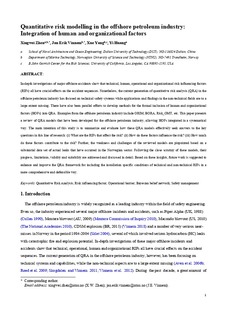| dc.contributor.author | Zhen, Xingwei | |
| dc.contributor.author | Vinnem, Jan Erik | |
| dc.contributor.author | Yang, Xue | |
| dc.contributor.author | Huang, Yi | |
| dc.date.accessioned | 2019-11-20T13:12:08Z | |
| dc.date.available | 2019-11-20T13:12:08Z | |
| dc.date.created | 2019-04-07T22:24:55Z | |
| dc.date.issued | 2019 | |
| dc.identifier.citation | Ships and Offshore Structures. 2019, 1-19. | nb_NO |
| dc.identifier.issn | 1744-5302 | |
| dc.identifier.uri | http://hdl.handle.net/11250/2629525 | |
| dc.description.abstract | In-depth investigations of major offshore accidents show that technical, human, operational and organisational risk influencing factors (RIFs) all have crucial effects on the accident sequences. Nonetheless, the current generation of quantitative risk analysis (QRA) in the offshore petroleum industry has focused on technical safety systems while applications and findings in the non-technical fields are to a large extent missing. There have also been parallel efforts to develop methods for the formal inclusion of human and organisational factors (HOFs) into QRA. Examples from the offshore petroleum industry include ORIM, BORA, Risk_OMT, etc. This paper presents a review of QRA models that have been developed for the offshore petroleum industry, allowing HOFs integrated in a systematical way. The main intention of this study is to summarise and evaluate how these QRA models effectively seek answers to the key questions in this line of research: (i) What are the RIFs that affect the risk? (ii) How do these factors influence the risk? (iii) How much do these factors contribute to the risk? Further, the weakness and challenges of the reviewed models are pinpointed based on a substantial data set of actual leaks that have occurred in the Norwegian sector. Following the close scrutiny of these models, their progress, limitations, validity and suitability are addressed and discussed in detail. Based on these insights, future work is suggested to enhance and improve the QRA framework for including the installation specific conditions of technical and non-technical RIFs in a more comprehensive and defensible way. | nb_NO |
| dc.language.iso | eng | nb_NO |
| dc.publisher | Taylor & Francis | nb_NO |
| dc.relation.uri | https://www.tandfonline.com/doi/full/10.1080/17445302.2019.1589772 | |
| dc.title | Quantitative risk modelling in the offshore petroleum industry: integration of human and organizational factors | nb_NO |
| dc.type | Journal article | nb_NO |
| dc.type | Peer reviewed | nb_NO |
| dc.description.version | acceptedVersion | nb_NO |
| dc.source.pagenumber | 1-19 | nb_NO |
| dc.source.journal | Ships and Offshore Structures | nb_NO |
| dc.identifier.doi | 10.1080/17445302.2019.1589772 | |
| dc.identifier.cristin | 1690727 | |
| dc.relation.project | Norges forskningsråd: 254913 | nb_NO |
| dc.description.localcode | Locked until 8.3.2020 due to copyright restrictions. This is an [Accepted Manuscript] of an article published by Taylor & Francis in [Ships and Offshore Structures ] on [date], available at https://doi.org/10.1080/17445302.2019.1589772 | nb_NO |
| cristin.unitcode | 194,64,20,0 | |
| cristin.unitname | Institutt for marin teknikk | |
| cristin.ispublished | true | |
| cristin.fulltext | postprint | |
| cristin.qualitycode | 1 | |
